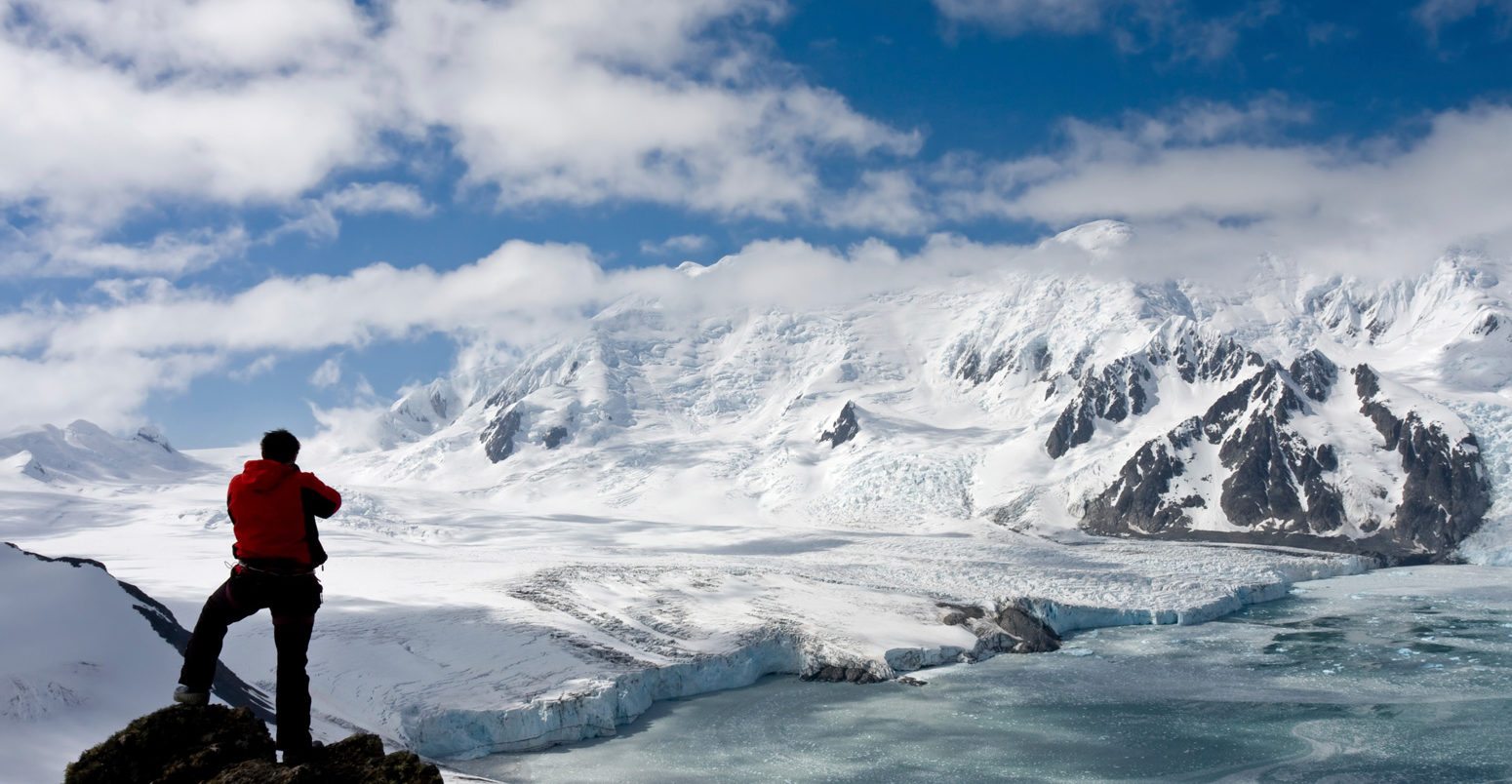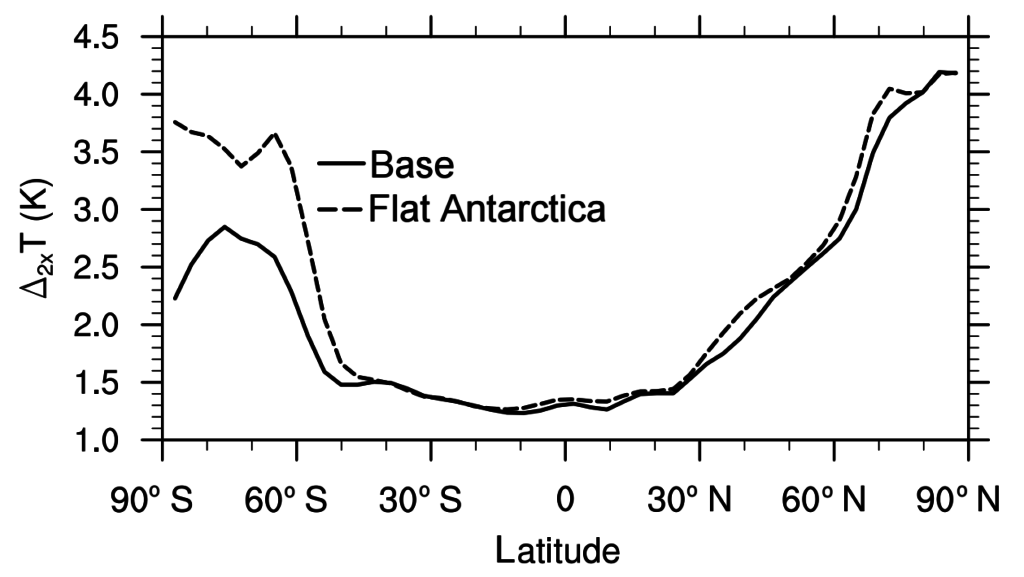
Antarctica’s high elevation is slowing rate of warming, says study
Robert McSweeney
05.18.17Robert McSweeney
18.05.2017 | 2:21pmTemperatures in the Arctic are increasing around three times as fast as the global average, yet the pace of warming has been much slower at Earth’s other pole.
A new study, just published in Earth System Dynamics, suggests the difference might – in part – be down to the great heights of Antarctica’s land surface.
The soaring mountain ranges and thick ice sheets put Antarctica’s average elevation at more than two kilometres above sea level. In contrast, the Arctic is predominantly ocean, covered by sea ice a few metres thick.
This extra height inhibits the flow of warm air coming up from lower latitudes, the study says, and it accounts for around half of the difference in the pace of warming between the Arctic and Antarctic.
The results suggest that warming in the Antarctic could speed up in the centuries to come as the ice sheets flatten out as they melt.
‘Important piece of the puzzle’
Scientists expect that as the Earth heats up in response to human-caused CO2 emissions, the rate of warming will be greatest at the poles. There are a number of reasons for this.
One is that as the ice-covered poles melt, energy from the sun that would have been reflected away is instead absorbed by the ocean or the land beneath. Another is that the air over the poles is very dry and cold. In the tropics, for example, the warm, moist air rises and condenses to form huge rain clouds, which cools the land surface. This doesn’t happen at the poles. A third reason is that as the poles warm, they affect how circulation patterns in the ocean and atmosphere carry heat up from lower latitudes.
These factors have been very much in evidence in the Arctic, which has warmed at a rate of 0.6C per decade over the last 30 years, compared to 0.17C per decade globally. This phenomenon is known as Arctic amplification.
But at the other end of the planet, warming has been much more sluggish. Over the past 50 years, the average temperature of Antarctica as a whole has risen by around 0.12C per decade. This is mainly driven by warming in the West Antarctic and Antarctic Peninsula, while some parts of East Antarctica have cooled slightly.
Part of the reason for this slower pace of warming is because Antarctica is much colder than the Arctic, which means it takes more warming to get ice melting in the first place. It’s also because Antarctica’s ice sheets are hundreds of metres thick – compared to Arctic sea ice of a few metres. This means a lot more ice needs to melt to uncover the dark land surface beneath.
Other research has also suggested that the hole in the Ozone Layer above Antarctica has helped limit warming by strengthening the winds over the Southern Ocean, thus cooling the surface.
But these factors don’t fully explain why the effect of Antarctic amplification is smaller than Arctic amplification. The author of the new study, Dr Marc Salzmann from the University of Leipzig, tells Carbon Brief that the high land surface of the Antarctic might be an “important piece of the puzzle.”
Surface height
To test his theory, Salzmann ran two sets of climate model simulations where the amount of CO2 in the atmosphere was set at 569 parts per million – double that of pre-industrial levels. To put that in context, 2016 will be the first full year in which global average CO2 levels stay above 400ppm.
The first set simulated Antarctica as we know it (or, at least, how a lot of intrepid explorers know it). In the second set, Salzmann artificially lowered the height of Antarctica’s land surface in the model to a constant one metre.
Comparing the two sets of model outputs, Salzmann found that warming in Antarctica was much more rapid when the land surface was just a metre high – reducing the difference between Arctic and Antarctic amplification.
You can see this in the chart below, which shows the change in temperature across the whole latitude of the Earth for a doubling of CO2, from the south pole (left-hand side) to the north (right). It shows how much larger the temperature response is in Antarctica when it is simulated as flat (dashed line) compared to its true elevation (solid line).

Simulated surface air temperature increase by latitude for a doubling of CO2 for a flat Antarctica (dashed line) and at its true elevation (solid line). Source: Salzmann (2017)
Overall, Salzmann found that the extra land surface height that Antarctica has over the Arctic accounted for 56% of the difference in their rates of warming – though this ranged between 24% and 80% across all his simulations.
Heat transport
So, why does reducing Antarctica’s height lead to more warming?
There are a few factors in play, but the main one is how Antarctica’s mountains and ice inhibit the flow of air at the Earth’s surface and thus the transfer of heat, explains Salzmann:
“The massive ice sheet and the mountains below prevent atmospheric heat transport [from lower latitudes]. A part of the space that would otherwise be filled by the atmosphere is taken up by the ice sheet and also by the mountains below the ice sheet.”
Without them in the way, the transfer of warm air from lower latitudes to Antarctica becomes more efficient, says Salzmann, bringing a stronger pace of warming.
Another reason is perhaps more obvious. Without ice sheets and mountains, there’s more space for the lower atmosphere to fill. This means that there’s more CO2 and water vapour in the air above the surface, which increases the warming impact they have on the land below.
The European Geosciences Union, which publishes the Earth System Dynamics journal, has produced a short video to explain the research.
‘More prone to melting’
While the study sheds light on why the pace of warming in the Arctic is outstripping that of the Antarctic, it also hints that warming at the south pole could become more rapid in future.
As Antarctica melts under human-caused warming, the height of the massive ice sheets will lower. This could speed up warming rates in the centuries to come, says Salzmann:
“In the long run, a successive lowering of the altitude of the ice sheet makes Antarctica more prone to melting.”
Previous research has suggested that this factor may have played a role in the long, slow transitions between ice ages and warm periods throughout Earth’s history, Salzmann adds.
But to get a better idea of how Antarctica could change on much shorter timescales – the next 100 years, for example – further research is needed, says Salzmann.
Salzmann, M. (2017) The polar amplification asymmetry: Role of antarctic surface height, Earth Systems Dynamics,doi:10.5194/esd-8-323-2017

